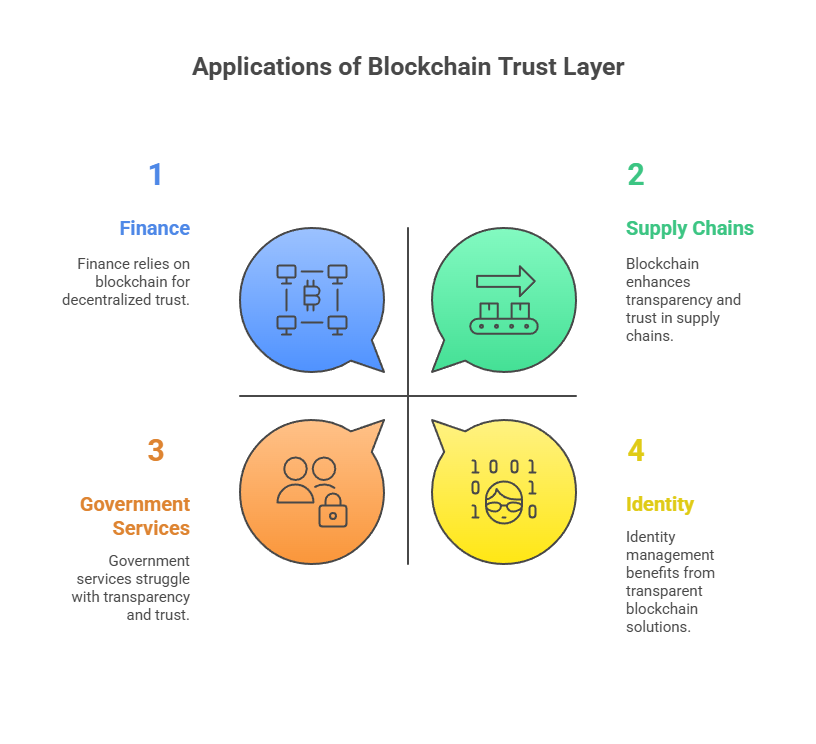What is Blockchain Trust Layer?

Fundamentally, blockchain serves as a layer or protocol that promotes trust. It is on the verge of becoming a crucial component of current computer systems. An infrastructure that automatically applies governance, provenance, and compliance criteria is required in a decentralized system of players without central authority or middlemen like banks. By allowing a trust layer over the internet, blockchain helps to meet this demand by making trust intermediation easier. Distributed ledger technology (DLT), disintermediation protocols, and decentralized infrastructure work together to accomplish this.
Traditionally, intermediaries like banks or credit card firms who validate credentials are used to build trust in systems like online banking or shopping. A decentralized system, on the other hand, does not have systems or people confirming usernames and passwords. An automated software method is offered by blockchain to fulfill this function. Around 2009, it created a trust layer in addition to HTTPS, the internet’s security layer. Web apps that are safe and reliable are made possible by this infrastructure. By means of validation and verification, it contributes code for trust intermediation to a broader system.
How the Trust Layer is Established and Maintained
A blockchain-based system’s trust layer is essentially constructed from a number of interrelated technology elements and procedures:
Verification and Validation
By confirming and validating pertinent participant information and transactions, trust is built. Whereas validation focuses on application-specific standards (such as verifying a boarding pass), verification handles generic or global needs (such as confirming identification). Both basic and application-specific rules and criteria are used to validate and verify transactions in a blockchain application. These procedures are essential to the intermediation of trust.
Recording with Consensus
After validation and verification, relevant data is permanently documented with the stakeholders’ consent. On a distributed immutable ledger, this recording takes place.
- Consensus Mechanism: This eliminates the need for a central authority by allowing all nodes to concur on the legitimacy of transactions and the sequence of blocks. Consensus makes ensuring that every distributed node has an accurate copy of the same batch of transactions (a block). Proofs of Authority, Work, Stake, and Practical Byzantine Fault Tolerance are consensus methods. A block is added to the chain after all parties agree it, and the consensus mechanism assures a consistent set of transactions on the blockchain.
- Distributed Ledger Technology (DLT): Several users frequently own identical copies of the ledger, which is distributed and maintained by participating nodes. This distribution makes the ledger tamper-resistant and visible, as does the cryptographic linkage between blocks. They are trusted for financial transactions due to this characteristic, as well as the immutable nature of stored data. There can be a “single, shared version of the truth” throughout the network since the ledger is distributed and shared.
Cryptography
The foundation of blockchain technology, cryptography offers the necessary components for building trust. Digital signatures and distinct digital identities (account addresses) are made possible by public-private key pairs. Digital signatures authenticate, non-repudiate, and are intact. Hashing is vital for consensus, digital signing, and data integrity. Private-public key cryptography uniquely identifies accounts and protects assets.
Smart Contracts
These are blockchain-based executable programs that automate corporate processes. Through the addition of programmability for application-specific validation and verification, they strengthen the fundamental trust made possible by the blockchain protocol. Rules for integrity and trust are implemented using smart contracts. These constraints are implemented using language features such as modifiers (require(), revert(), assert()), which serve as gatekeepers to regulate access and consistently validate data. Because it stops invalid transactions from being entered into the immutable ledger, the revert() declaration is especially crucial in preventing the accumulation of invalid data. Smart contracts are thought to be more reliable than traditional contracts since they are transparent and secure.
Trustless vs Trust Layer
When discussing blockchain, especially permissionless networks like Bitcoin, the word “trustless” is frequently used. This indicates that transactions are not being certified by any reliable third party. This does not imply, however, that trust is completely unnecessary. Trust is redistributed and placed in the technology itself, including the code, the distributed network, the consensus methods, and the cryptographic procedures, rather than in a single institution. Even in permissionless networks, a certain amount of confidence is still needed in the software developers, the cryptographic technologies, the proper functioning of smart contracts (which emphasizes the importance of auditing), and the fact that most users are not secretly conspiring.
The blockchain’s features serve to reinforce the trust that users may already have in permissioned blockchain networks. Because publishing nodes have mutual trust, the consensus approach might be quicker and less computationally costly.
Applications of the Trust Layer

When players lack a conventional foundation for trust, the trust layer made possible by blockchain is very helpful. In a number of fields, it offers a method for safe interactions and verified procedures:
Supply Chains
Blockchain solves trust difficulties brought on by a lack of visibility by enhancing transparency and traceability. Members are held accountable and trust is increased when data is recorded accurately and irrevocably. Blockchain makes procurement more transparent and trustworthy.
Finance
Blockchain provides a decentralized method, whereas traditional systems depend on organizations like banks as reliable middlemen. By serving as the price of trust, the usage of cryptocurrencies and related costs (such as gas and miner fees) help guarantee correct operation and foster confidence.
Government Services
By serving as a distributed, trusted, and unchangeable shared ledger, blockchain can secure citizen data in communications. In systems like VAT management, it aids in addressing trust issues such as data inequality.
Identity
The secret to digital identity is cryptography. Blockchain can securely manage and share trustworthy credentials by utilizing PKI principles.
Also Read About Role Of Cryptography In Blockchain Explained For Beginners
Conclusion
In conclusion, the blockchain trust layer is a technological construct that automates and enforces trust in decentralized systems without the need for traditional middlemen by utilizing distributed ledgers, smart contracts, consensus processes, and cryptography. It allows individuals who might not directly trust one another to engage securely by transferring trust from a single third party to an immutable, transparent, and verifiable network.
